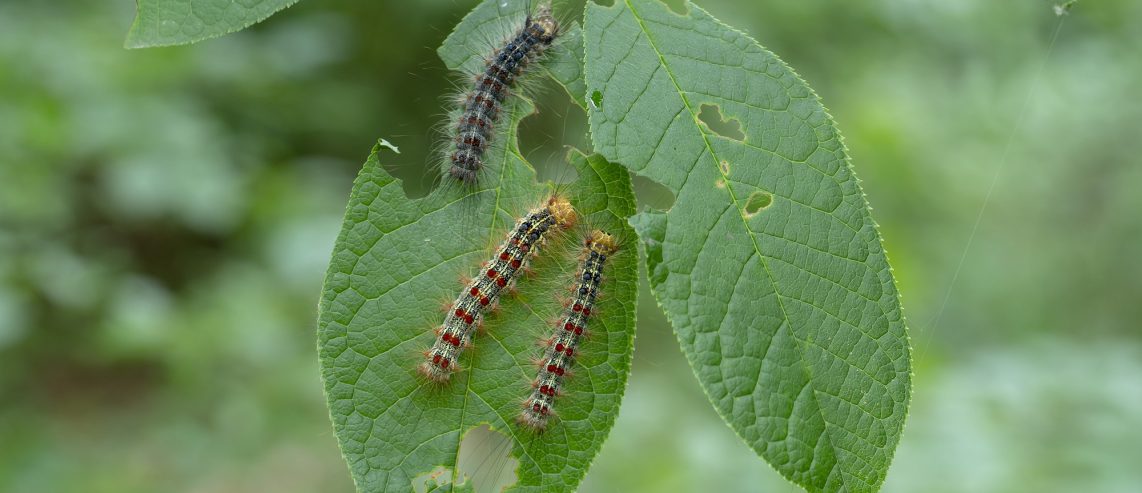A caterpillar invasion may sound harmless. After all, what kind of damage can these fuzzy creatures cause? If we’re talking about the spongy moth caterpillar, a lot, it turns out.
In their early stages in the spring, tiny spongy moth caterpillars are difficult to avoid. You may not mean to, but you can come into contact with them by accident. That’s bad news because they can cause an allergic reaction.
Here’s what you should know about spongy moth caterpillars before you head outdoors.
Why Are Spongy Moth Caterpillars a Problem?
Spongy moths, or Lynmatria dispar, first appeared in the U.S. from Europe in 1869 after escaping from the home of an amateur bug collector in Massachusetts. You may know them as gypsy moths, but their common name changed to spongy moth in 2022.
Spongy moths are now in at least 20 Eastern and Midwestern states, including Pennsylvania. During outbreak years like this year, doctors see more allergic reactions to spongy moth caterpillar stings.
Spongy moth caterpillars have tiny hairs called setae that can get stuck in your skin. Proteins coating the setae can trigger an immune system reaction in some people. Others may not have any reaction to it.
If you have an allergic reaction, you may notice symptoms right away. Or you might not notice any symptoms for a few hours. Depending on where the setae get stuck, the caterpillar sting can cause different symptoms, including a caterpillar rash.
What Does a Caterpillar Rash Look Like?
Symptoms of a spongy moth caterpillar rash include:
- Bumps, blistering, or welts.
- Itching.
- Irritated, red skin.
Never Miss a Beat!
Subscribe to Our HealthBeat Newsletter!
Thank you for subscribing!
You can now select the specific newsletters you'd like to receive.
You are already subscribed.
Subscribe to more newsletters in our email preference center.
Sorry, an error occurred. Please try again later.
Get Healthy Tips Sent to Your Phone!
Where Can You Find Spongy Moth Caterpillars?
You can find spongy moth caterpillars in forests and your backyard — wherever there are host trees, which they use for food. These caterpillars feed on over 300 different species of trees, according to the U.S. Department of Agriculture.
Spongy moth caterpillars can defoliate or eat all the leaves of a tree, sometimes even killing it. Left untreated, they can destroy forests and gardens as they munch their way through them. They’re most likely to feed on:
- Apple trees.
- Aspen trees.
- Basswood trees.
- Oak trees.
- Paper birch trees.
- Willow trees.
When Can You Find Spongy Moth Caterpillars?
In the fall, each female spongy moth can lay up to 800 eggs on a tree trunk. Each egg looks like a fuzzy, tan, oval-shaped mass about the size of a quarter. The caterpillars hatch the following spring.
When trees bud in the spring, that’s when spongy moth caterpillars emerge. Since early this May, towns and counties in central Pennsylvania have issued public health warnings about the spongy moth caterpillar.
Each big spongy moth outbreak can last two to three years. As they grow into adults, spongy moth caterpillars go through several larval or life stages called caterpillar instars. These stages take place over six to eight weeks during May and June — when you’re most likely to get caterpillar stings.
What Do Spongy Moth Caterpillars Look Like?
To protect yourself from spongy moth caterpillars, it helps to know what they look like. When they’re small, they can look like fuzzy dark brown specks. As they get larger, their hairs look like clumps of orange spikes.
The USDA’s National Slow the Spread Program at SlowTheSpread.org has photos of spongy moths and spongy moth caterpillars.
Early caterpillar instars are less than a quarter of an inch long and look like specks of moving dirt. Spongy moth caterpillars can dangle from trees by the silk threads they weave. A breeze can blow them onto nearby trees and other surfaces, including lawn furniture, playground equipment, and you.
The caterpillar also sheds its hairy skin through each life stage. When this skin becomes airborne — which often happens with spongy moth caterpillars — it can get into your eyes, mouth, nose, or respiratory tract.
By July, the caterpillars transition to pupae or chrysalises, a process that takes a week or two. From there, they emerge into winged moths. Spongy moths don’t cause an allergic reaction, but the cycle starts again when they lay their eggs in the early fall.
How to Prevent Spongy Moth/Gypsy Moth Allergy?
The best way to prevent a spongy moth caterpillar allergy is to:
- Avoid areas with lots of trees.
- Cover your skin as much as possible, especially outdoors in May and June. Wear long sleeves and pants and cover your head, especially when hiking or gardening.
- Don’t touch caterpillars with bare hands.
How Do You Treat Caterpillar Allergies?
If you or someone else gets a caterpillar sting, call Poison Control at 1-800-222-1222 or use the webPOISONCONTROL® online tool for treatment guidance. Both services are free, confidential, and available 24 hours a day.
These are the general guidelines from the National Capital Poison Center for treating caterpillar stings. If the caterpillar is still on your skin, brush it off without using your hands. Treatment for caterpillar allergies starts with removing the caterpillar hairs from your skin.
How do you remove caterpillar hairs from skin?
Caterpillar hairs are often microscopic or hard to see with the naked eye. To remove caterpillar hairs, take a strip of tape, gently put it sticky side down on your skin, then pull the tape up. Repeat the process over your skin with a new piece of tape until you remove all the caterpillar hairs.
Treatment for gypsy moth allergy/spongy moth allergy
To treat an instant skin reaction from a spongy moth caterpillar sting, follow these steps after removing the caterpillar hairs:
- Wash the contact area with soap and water.
- Apply ice or a cold compress.
- Apply an over-the-counter topical anti-itch cream, ointment, or spray to your skin. If you don’t have these in your medicine cabinet, you can apply a paste of baking soda and water.
If you have a more severe itch, apply a topical steroid cream or ointment containing hydrocortisone. Your doctor can also prescribe stronger prescription steroid creams or ointments.
You can take oral antihistamines like Benadryl if you get a hive-like rash.
When to Get Medical Care?
If spongy moth caterpillar hairs get into your eyes, mouth, nose, or throat, get medical help. Symptoms can include:
- Cough.
- Drooling.
- Headache.
- Increased tears or red eyes.
- Inflamed membranes or redness inside your nose.
- Nausea or upset stomach.
- Pain.
If the caterpillar stings your eyes, flush it with plenty of water and get medical help. If your child eats or swallows a spongy moth caterpillar, look for signs of a swollen mouth or throat and get medical help. Swallowing these caterpillars can also cause vomiting.
Severe allergic reactions are rare, but they can happen. Seek medical care right away if you have:
- Difficulty swallowing.
- Mouth and throat burning or swelling.
- Shortness of breath.
- Swelling at the rash site.
The good news is that a spongy moth caterpillar rash isn’t contagious. Most symptoms with treatment last only a few hours or days.
Sources
National Capital Poison Center. Are Caterpillars Poisonous? Link
MedlinePlus. Caterpillars. Link
The Standard-Journal. Moth 'invasion' sparking attention in Central Pennsylvania. May 3, 2024. Link
USDA Forest Service. Slow the Spread: a national program to manage the gypsy moth. Link
USDA Forest Service. Forest Insect and Disease Leaflet 162: Spongy Moth. Link
About UPMC
Headquartered in Pittsburgh, UPMC is a world-renowned health care provider and insurer. We operate 40 hospitals and 800 doctors’ offices and outpatient centers, with locations throughout Pennsylvania, Maryland, New York, West Virginia, and internationally. We employ 4,900 physicians, and we are leaders in clinical care, groundbreaking research, and treatment breakthroughs. U.S. News & World Report consistently ranks UPMC Presbyterian Shadyside as one of the nation’s best hospitals in many specialties and ranks UPMC Children’s Hospital of Pittsburgh on its Honor Roll of America’s Best Children’s Hospitals. We are dedicated to providing Life Changing Medicine to our communities.

